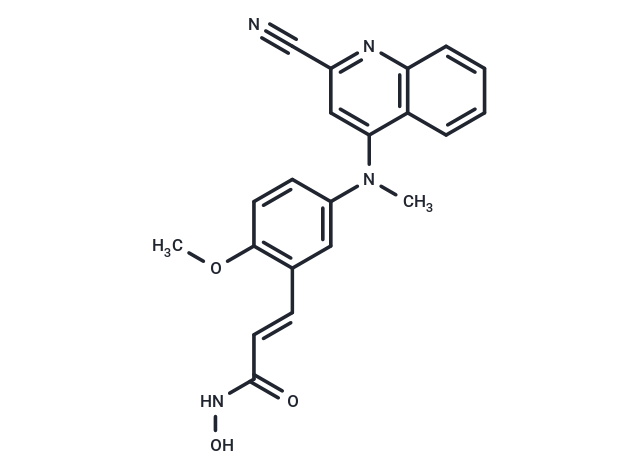Shopping Cart
- Remove All
 Your shopping cart is currently empty
Your shopping cart is currently empty

Tubulin/HDAC-IN-1 is a dual inhibitor of tubulin and HDAC8, interacting with tubulin via CH/π interactions and with HDAC8 through hydrogen bonds. It effectively inhibits tubulin polymerization and selectively targets HDAC8 with an IC50 of 150 nM. Additionally, Tubulin/HDAC-IN-1 demonstrates cytotoxicity against various human cancer cells, induces cell cycle arrest in the G2/M phase, and triggers cell apoptosis, making it valuable for studying hematologic and solid tumors, including neuroblastoma and leukemia [1].

| Pack Size | Price | Availability | Quantity |
|---|---|---|---|
| 25 mg | $1,520 | 6-8 weeks | |
| 50 mg | $1,980 | 6-8 weeks | |
| 100 mg | $2,500 | 6-8 weeks |
| Description | Tubulin/HDAC-IN-1 is a dual inhibitor of tubulin and HDAC8, interacting with tubulin via CH/π interactions and with HDAC8 through hydrogen bonds. It effectively inhibits tubulin polymerization and selectively targets HDAC8 with an IC50 of 150 nM. Additionally, Tubulin/HDAC-IN-1 demonstrates cytotoxicity against various human cancer cells, induces cell cycle arrest in the G2/M phase, and triggers cell apoptosis, making it valuable for studying hematologic and solid tumors, including neuroblastoma and leukemia [1]. |
| In vitro | Tubulin/HDAC-IN-1 (Compound 12a) exhibits pronounced cytotoxicity with an average IC50 of 0.6 nM across various human cancer cell lines. In HT29 cells, 2 nM application induces G2/M phase arrest and caspase-mediated apoptosis via mitochondrial dysfunction over 24 hours. The compound selectively inhibits HDAC8 with an IC50 of 150 nM, and also inhibits HDAC6 and HDAC11 at higher concentrations (1 μM and 1.9 μM, respectively). It increases γH2AX and acetylated SMC3 levels in a dose-dependent manner at 0.5-100 nM, indicating DNA damage and cell stress. Tubulin polymerization is impeded dose-dependently, particularly notable at 5-15 μΜ, and at 250 nM, it disrupts the microtubule network non-specifically. The compound shows good in vitro metabolic stability, observed in intrinsic clearance rates for rat and human liver microsomes. Comprehensive evaluation through cell proliferation assays and western blot analysis in HT-29 cells underscores its potential as a cancer therapeutic agent. |
| In vivo | Tubulin/HDAC-IN-1 (Compound 12a), administered intratumorally at 0.25 mg/kg three times weekly for two weeks, significantly reduced MCA205 tumor growth and improved overall survival in a C57BL/6 allogeneic sarcoma mouse model. The study [1] also evaluated 0.1 and 0.50 mg/kg dosages, showing decreased tumor growth and extended survival without evident adverse effects. |
| Molecular Weight | 374.39 |
| Formula | C21H18N4O3 |
| Cas No. | 2413587-26-3 |
| Storage | Powder: -20°C for 3 years | In solvent: -80°C for 1 year | Shipping with blue ice. |

Copyright © 2015-2025 TargetMol Chemicals Inc. All Rights Reserved.